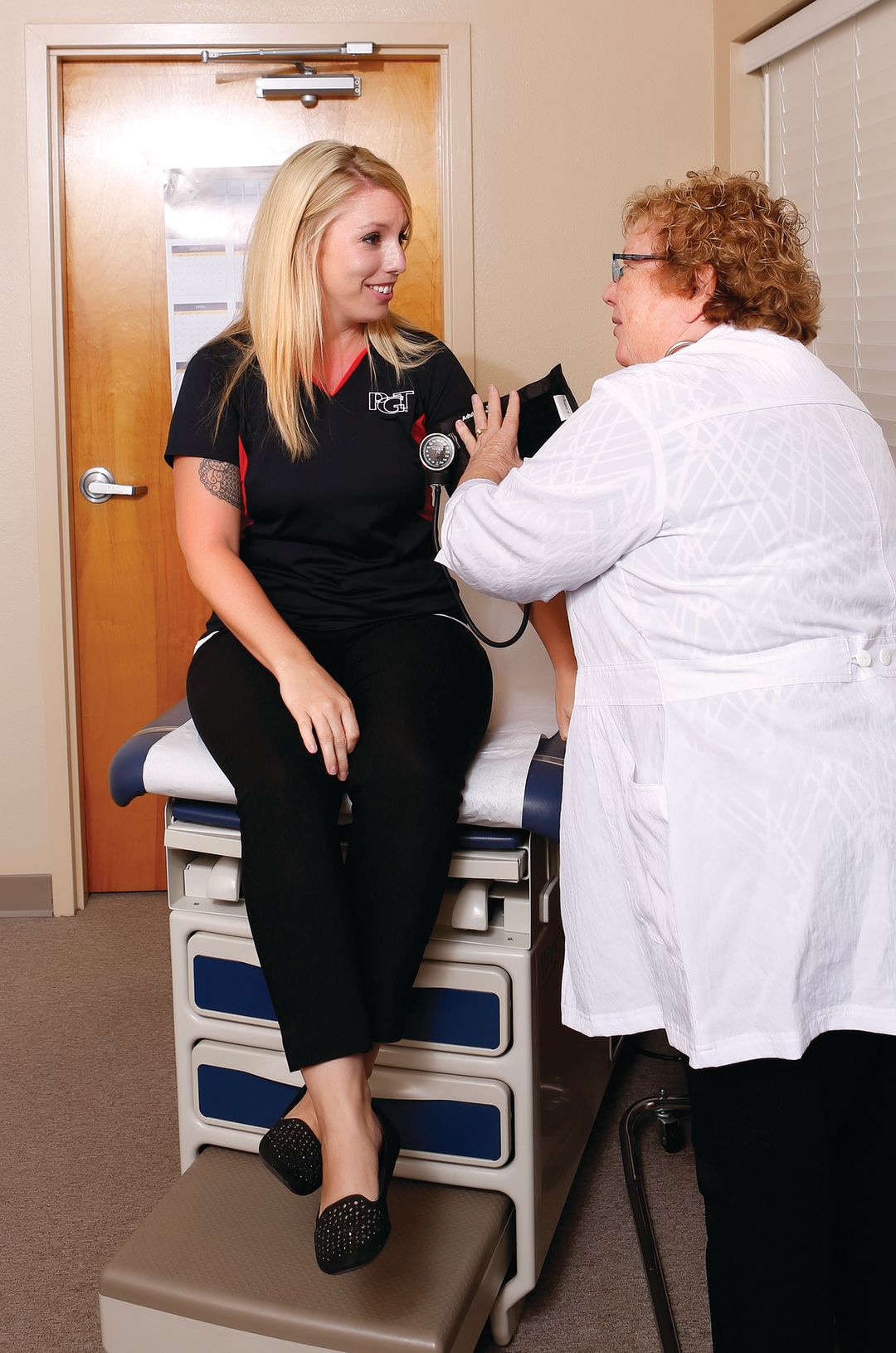How to Find and Keep Workers

More companies are interacting with employees on social media.
Image: Shutterstock
These are golden days for PGT Innovations, Inc. The Venice-based manufacturer of impact-resistant doors and windows has seen net revenues soar nearly 45 percent in the past three years. Its stock price, which plunged to 88 cents during the depths of the Great Recession, exceeded $12 earlier this year. And the company is not only running three shifts at its local plant, it has acquired three operations near Miami and Orlando.
Yet one challenge keeps PGT president and chief operating officer Jeff Jackson up at night.
“Plain and simple, it’s labor,” Jackson says. “Can we get and retain enough qualified workers? That’s our challenge right now, as it is for many businesses.”
PGT has seen its workforce, which dipped to under 1,000 during the downturn, swell to more than 2,600 today, closing in on Publix as the largest private employer in the Sarasota-Bradenton Metropolitan Area.
“And we have 130 positions I’d fill today if we had the right candidates,” Jackson recently said. “But you can’t just hope they will walk through the door.”
PGT’s challenge is shared by businesses across the region, who have gone from wringing their hands over layoffs to a full-throttle switch forward to find new workers and keep the ones they have. The Sarasota-Bradenton unemployment rate, which reached 12.2 percent in 2010, fell to 3.7 percent in April, the lowest rate in a decade. Nationally, the United States had a record 6 million job openings this spring, according to the Labor Department, compared to just 2.2 million during the depths of the recession in 2009.
Demographics add another layer to the challenge: Younger workers are job-hopping at unprecedented rates. A 2016 study by the networking site Linkedin found that millennials averaged nearly three jobs in their first five years out of college—double the rate of Generation Xers. Compounding the challenge, a wave of baby boomers—the most stable part of the workforce—is heading to retirement.
“There’s a war on for talent right now,” says Laurie Bennett, executive director of human resources for Sarasota Memorial Hospital. “It’s our No. 1 priority.”
Companies are responding with major changes in how they attract employees and what they are doing to keep them. Here are some successful strategies that could benefit your company.
Hiring strategy: Cast a wide net
The days of being able to fill job openings by relying on a file cabinet of applicants, putting a Help Wanted advertisement in the Sunday newspaper or sticking a sign such as “Job Opening, Apply Within” outside the business are long gone, says Pat Mathews, principal of Workplace Experts, a Sarasota-based human resources consulting firm.
“But it’s amazing how many businesses haven’t gotten the message,” Mathews laments. “When I see those ‘Now Hiring’ signs outside a business, it strikes fear in my heart. It sends the message: ‘We’re desperate.’ There are so many more effective ways to do it.”
Sarasota Memorial Hospital, which has 5,400 employees and 300 to 400 openings at any given time, is casting a national net to lure applicants. Between 30 percent to 40 percent of SMH’s recruiting efforts now go through social media sites such as Facebook, Indeed, LinkedIn and Twitter, with only 5 percent devoted to the previous staple, advertisements in print media. The hospital sells not only its workplace, but the Sarasota lifestyle of beaches, warm weather and culture.
“We used to post and pray,” Bennett says. “Now, we’re going after people.”
SMH changed its employment portal into a “candidate relationship manager.” Candidates who respond through Facebook, for example, can register in 20 seconds, Bennett says, providing their name, email address and job interests. SMH then interacts with the prospects, notifying them when jobs in their fields open and sending email blasts, for example, when the hospital is recognized as a top place to work. More than 8,000 potential candidates are now in SMH’s system. In addition, the hospital made job applications accessible on mobile devices. Bennett says one-third of applications now come through cell phones or tablets.
Companies still use jobs sites such as Monster and CareerBuilder to find candidates. But they are also increasingly focusing on Facebook posts, for example, that do not even mention a specific job opening and are designed to pique the interest of a talented worker not actively seeking another job.
“By marketing your brand, your culture, you attract candidates who may not even be actively looking,” Mathews said. “They say, ‘Wow, that looks like a great place to work.’”
McDonald’s, which is hiring 250,000 summer workers, has created an application process called “Snaplications” using the social media mobile app Snapchat. Users nationwide access 10-second video ads of restaurant employees talking about working at McDonald’s. They can then “swipe up” to visit the McDonald’s career webpage in Snapchat to see openings and apply for jobs.
The ability to easily get a company’s message out not just regionally but across the country allows employers to target areas ripe with potential applicants. For example, Bennett says, SMH recently targeted Texas after that state had large layoffs in health care.
Even as companies are casting a wider net, they also are turning internally through employee referral programs to connect with candidates. PGT is among a growing number of companies that gives financial bonuses to employees who refer successful hires. An employee who refers a hire earns $25 if both the employee and the new worker are employed in good standing after 90 days; $50 more after 180 days and another $100 after a year, for a total of $175.
“What better endorsement can we get than from an employee who loves his or her job?” Jackson says. Nearly half of workers hired through PGT’s employee referral programs are still on the job after two years, which is significantly better than the company’s overall retention rate.

Sarasota Memorial Hospital offers daycare for the children of its employees.
Image: Jenn Soos
Start strong: The first days are critical
Companies often spend thousands of dollars and many work hours to attract and hire a great employee. Many of those employees walk out the door before their desk chair is even warm.
“Thirty-three percent of new workers quit within six months,” Mathews says. “And most of those who quit know that they are going to do it within their first week on the new job. That’s why the ‘onboarding’ process is so vital.”
Mathews says managers and human resources should follow up with new employees at set periods, including after the first week. Ask the new hires whether the job is what they expected and, if not, what changes or adjustments they would like to see. Employees want transparency and open lines of communication. They want to feel that their voice is heard and that they know what is going on beyond their work station.
Another important step, says Alicia Larkins, human resources director at Tervis, is to educate new hires about the company’s history and achievements.
“We’ve been here since 1946, and telling our new employees about our rich history helps develop a sense of pride in where they work,” Larkins says. “You can’t wait to do it. The first 90 days are critical.”
Small things can have a big impact on someone new to a job. Mathews says not having a prepared work area for a new employee or sending the new hire off for hours to fill out paperwork sends the wrong signal at a crucial moment.
At PGT, one of the first messages is that lines of communication are open. “We’ve learned to put a lot of effort into the first days and weeks,” says PGT’s Jackson, who has an open-door policy. “We know if we can keep an employee for five years, they’re often going to stay with us for the long term. And to get to that point, we have to make the start successful for them.”

PGT Innovations has a wellness center onsite.
Image: Jenn Soos
Retaining workers: It’s more than pay
PGT recently raised its starting wage from $10.25 to $11 an hour. Skilled workers can make between $18 to $24 an hour. But Jackson says benefits can be just as important, if not more so, in attracting, motivating and retaining employees.
In recent years, PGT has added a wellness center at its Venice campus where workers can get free basic medical care such as blood tests, prescriptions and referrals to specialists. There’s a free 24-hour fitness site. And in April the company broke ground on a $1.8 million child-care center for employees, with costs subsidized by PGT. Employees can also receive up to $50,000 to attend college or get other advanced training, education that leads to promotions and higher pay. An emergency loan program called the Crisis Connection helps employees get through tough financial times.
The city of Venice has also stepped in, approving in May the rezoning of 30 acres on Knights Trail Road near the city’s manufacturing hub, which includes PGT, Tervis and other businesses. Plans call for 534 apartments for moderate and low-income residents, with rents starting at $750. It is the area’s first affordable housing project in decades and, if achieved, will allow employees to live, get childcare and shop close to where the work.
“Housing costs are a huge issue,” Jackson says. “A lot of working-class families are being priced out of the market.”
Earlier this year, Sarasota Memorial was named one of the 150 Top Places to Work in Healthcare by Becker’s Hospital Review. Flexible scheduling options and customized benefits, including giving employees a variety of health insurance choices, are attractive to today’s workers, Bennett says. SMH has two child-care centers, a fitness facility that rivals the best in the area and counseling programs for employees dealing with personal issues.
“Pay is important,” Bennett says, “but benefits and flexibility matter a lot as well.”
Among HR directors, “engagement” is the buzzword. Bennett says employers can fuel engagement by ensuring workers have the tools and training to be successful and giving regular feedback to employees. Employees also want to feel “managers care about them,” she says, and that they have a friend at work.
Mathews says millennials, in particular, are looking for jobs that they enjoy, where they feel recognized and where they see a chance to advance. They want to be kept informed about what is happening at the company, the bad as well as the good. And they want to know that their voices are being heard.
“You can’t expect employees to communicate through a suggestion box,” she says.
Bealls department stores, which employs 500 at its Bradenton corporate headquarters, makes clear to employees their paths for advancement by exposing them to different jobs, says Cheryl Woeltjen, the company’s director of government and public affairs. For example, an employee doing entry-level work such as data entry is given exposure to work as an analyst or a fashion buyer.
“We’ve also added a formal mentoring program where we pair newer workers with mentors who are not their direct supervisor,” Woeltjen says. “It’s someone they can confide in without having to go to their boss.”
Finally, keeping a top employee sometimes means taking risks. Jackson tells the story of a good worker who had been at PGT for two years but who was fired when he did not show up for a shift and failed to notify his supervisor.
“When you’re on a production line and don’t show up, it’s a big problem; and you have to treat it seriously,” Jackson says. “But the employee called me, apologized and said he had some issues going on in his life. We gave him a second chance and it has worked out great. Keeping the human part of the equation is so important.”
Sun Hydraulics, Sarasota-based manufacturer of industrial valves and manifolds. employees: 621
The company receives 500 resumes annually for its summer internship program thanks to relationships it has built with college faculty around the country. About 30 engineering interns are chosen for the program, which pays up to $18 an hour and features a variety of “high-level responsibilities,” says Greg Glass, head of human capital. Between eight and 12 annually ascend to post-graduate internships, which often lead to full employment. “After going through these three steps, they know us and we know them,” Glass says. “Our turnover rate among engineers who have gone through the program is incredibly low, about 5 percent, and many of the former interns have gone on to play leading roles for us.”
Four Companies, Four Workforce Strategies
Bealls
Bradenton-based department store chain.
Employees: 10,000 in 17 states, including 500 at its local headquarters.
Bealls has boosted its hiring process by having candidates for jobs at corporate headquarters record video interviews through company software. Candidates talk about their experience and what skills they would bring to Bealls. “We get to see how they present themselves and whether they fit our organization,” says Cheryl Woeltjen, the company’s director of public and government affairs.
Gold Coast Eagle Distributing
Sarasota-based distributor for Anheuser-Busch and other products.
Employees: 223
Retaining workers “is a big challenge,” says human resources director Ford Snodgrass, particularly at Gold Coast’s warehouse, where the jobs are physically demanding and employees often work 60 hours a week. Gold Coast champions a generous benefits package that includes full medical, dental and life insurance coverage and college reimbursement. “We pay 100 percent of medical, dental and life insurance, which is rare these days,” Snodgrass says. The company also contributes a percentage of employee pay, up to 5 percent after five years, to a 401(K) retirement plan, contributions that employees are not required to match.
Tervis
Employs 700 overall, including nearly 500 at its Venice manufacturing plant and headquarters.
Millennials job-hop more than prior generations. To keep them at Tervis, the company last year added six weeks of parental leave at full pay for both mothers and fathers. The company also added a 100-day wellness challenge in which the 160 workers who participated received free Fitbits and fitness, sleep and other health assessments, says human resources director Alicia Larkins.
10 Tips to Retain Workers
1 Value results over face time. Remote workers are 50 percent less likely to quit.
2 Customize benefits and schedules to give employees options that suit their lifestyles.
3 Include specific retention targets in annual managerial goals.
4 Communicate regularly, directly and honestly about how the company is doing.
5 Show zero tolerance for harassment or bullying.
6 Make clear to employees the paths for advancement and what it takes to reach them.
7 Celebrate your company’s heritage and successes to burnish employee pride in where they work.
8 Reward employees whose referrals lead to successful hires.
9 Raise pay when deserving. A study found that 35 percent of workers who did not receive a raise in the previous 12 months were job hunting.
10 Consider benefits that go beyond the work area, such as fitness club memberships, child-care and educational reimbursements.



